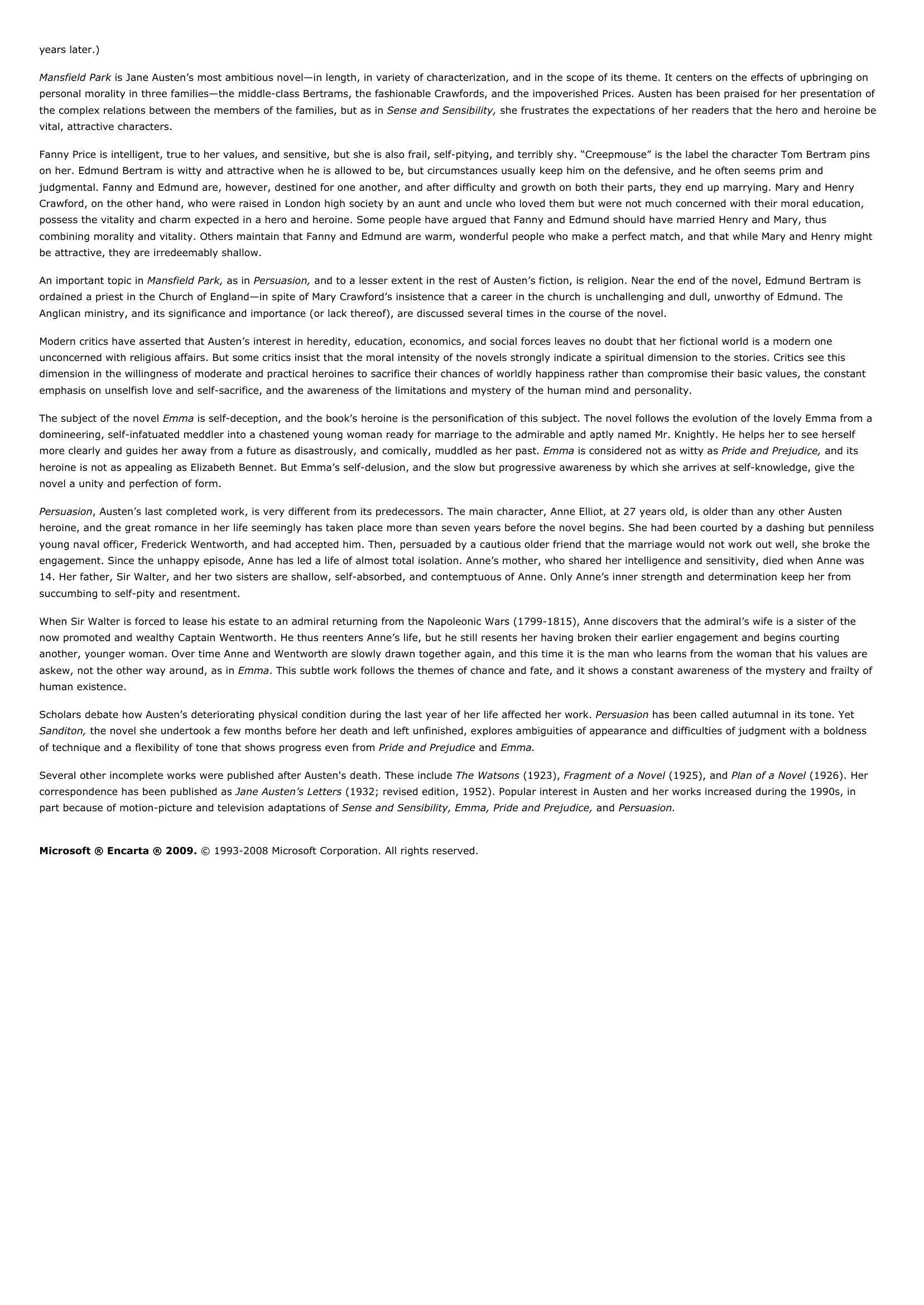Jane Austen.
Publié le 10/05/2013
Extrait du document
«
years later.)
Mansfield Park is Jane Austen’s most ambitious novel—in length, in variety of characterization, and in the scope of its theme.
It centers on the effects of upbringing on personal morality in three families—the middle-class Bertrams, the fashionable Crawfords, and the impoverished Prices.
Austen has been praised for her presentation ofthe complex relations between the members of the families, but as in Sense and Sensibility, she frustrates the expectations of her readers that the hero and heroine be vital, attractive characters.
Fanny Price is intelligent, true to her values, and sensitive, but she is also frail, self-pitying, and terribly shy.
“Creepmouse” is the label the character Tom Bertram pinson her.
Edmund Bertram is witty and attractive when he is allowed to be, but circumstances usually keep him on the defensive, and he often seems prim andjudgmental.
Fanny and Edmund are, however, destined for one another, and after difficulty and growth on both their parts, they end up marrying.
Mary and HenryCrawford, on the other hand, who were raised in London high society by an aunt and uncle who loved them but were not much concerned with their moral education,possess the vitality and charm expected in a hero and heroine.
Some people have argued that Fanny and Edmund should have married Henry and Mary, thuscombining morality and vitality.
Others maintain that Fanny and Edmund are warm, wonderful people who make a perfect match, and that while Mary and Henry mightbe attractive, they are irredeemably shallow.
An important topic in Mansfield Park, as in Persuasion, and to a lesser extent in the rest of Austen’s fiction, is religion.
Near the end of the novel, Edmund Bertram is ordained a priest in the Church of England—in spite of Mary Crawford’s insistence that a career in the church is unchallenging and dull, unworthy of Edmund.
TheAnglican ministry, and its significance and importance (or lack thereof), are discussed several times in the course of the novel.
Modern critics have asserted that Austen’s interest in heredity, education, economics, and social forces leaves no doubt that her fictional world is a modern oneunconcerned with religious affairs.
But some critics insist that the moral intensity of the novels strongly indicate a spiritual dimension to the stories.
Critics see thisdimension in the willingness of moderate and practical heroines to sacrifice their chances of worldly happiness rather than compromise their basic values, the constantemphasis on unselfish love and self-sacrifice, and the awareness of the limitations and mystery of the human mind and personality.
The subject of the novel Emma is self-deception, and the book’s heroine is the personification of this subject.
The novel follows the evolution of the lovely Emma from a domineering, self-infatuated meddler into a chastened young woman ready for marriage to the admirable and aptly named Mr.
Knightly.
He helps her to see herselfmore clearly and guides her away from a future as disastrously, and comically, muddled as her past.
Emma is considered not as witty as Pride and Prejudice, and its heroine is not as appealing as Elizabeth Bennet.
But Emma’s self-delusion, and the slow but progressive awareness by which she arrives at self-knowledge, give thenovel a unity and perfection of form.
Persuasion , Austen’s last completed work, is very different from its predecessors.
The main character, Anne Elliot, at 27 years old, is older than any other Austen heroine, and the great romance in her life seemingly has taken place more than seven years before the novel begins.
She had been courted by a dashing but pennilessyoung naval officer, Frederick Wentworth, and had accepted him.
Then, persuaded by a cautious older friend that the marriage would not work out well, she broke theengagement.
Since the unhappy episode, Anne has led a life of almost total isolation.
Anne’s mother, who shared her intelligence and sensitivity, died when Anne was14.
Her father, Sir Walter, and her two sisters are shallow, self-absorbed, and contemptuous of Anne.
Only Anne’s inner strength and determination keep her fromsuccumbing to self-pity and resentment.
When Sir Walter is forced to lease his estate to an admiral returning from the Napoleonic Wars (1799-1815), Anne discovers that the admiral’s wife is a sister of thenow promoted and wealthy Captain Wentworth.
He thus reenters Anne’s life, but he still resents her having broken their earlier engagement and begins courtinganother, younger woman.
Over time Anne and Wentworth are slowly drawn together again, and this time it is the man who learns from the woman that his values areaskew, not the other way around, as in Emma .
This subtle work follows the themes of chance and fate, and it shows a constant awareness of the mystery and frailty of human existence.
Scholars debate how Austen’s deteriorating physical condition during the last year of her life affected her work.
Persuasion has been called autumnal in its tone.
Yet Sanditon, the novel she undertook a few months before her death and left unfinished, explores ambiguities of appearance and difficulties of judgment with a boldness of technique and a flexibility of tone that shows progress even from Pride and Prejudice and Emma.
Several other incomplete works were published after Austen's death.
These include The Watsons (1923), Fragment of a Novel (1925), and Plan of a Novel (1926).
Her correspondence has been published as Jane Austen’s Letters (1932; revised edition, 1952).
Popular interest in Austen and her works increased during the 1990s, in part because of motion-picture and television adaptations of Sense and Sensibility, Emma, Pride and Prejudice, and Persuasion.
Microsoft ® Encarta ® 2009. © 1993-2008 Microsoft Corporation.
All rights reserved..
»
↓↓↓ APERÇU DU DOCUMENT ↓↓↓
Liens utiles
- Le personnage de BENNET (les) de Jane Austen
- CATHERINE MORLAND ou L’abbaye de Northanger Jane Austen (résumé & analyse)
- WOODHOUSE (Miss Emma). Personnage du roman de Jane Austen Emma
- EMMA Jane Austen (résumé)
- ORGUEIL ET PRÉJUGÉS de Jane Austen - résumé, analyse

































